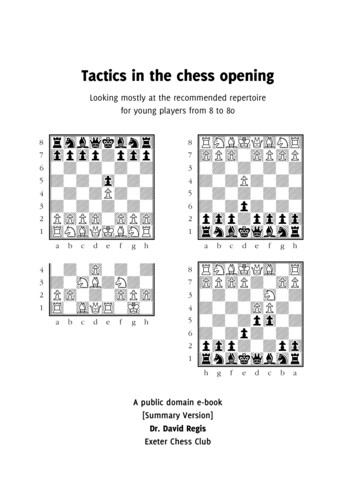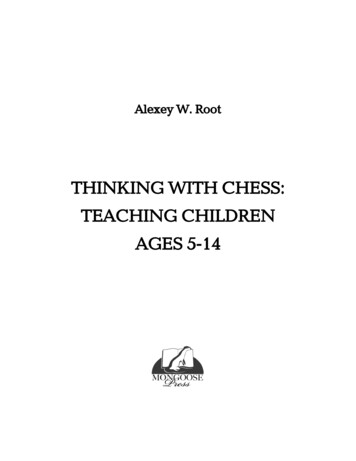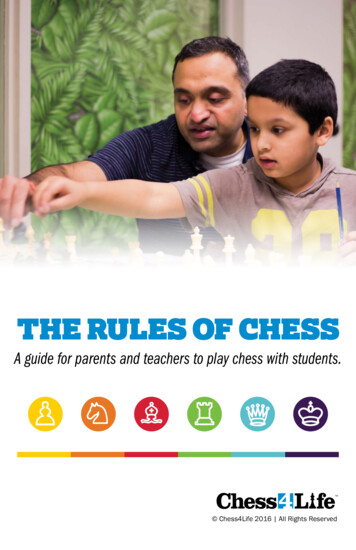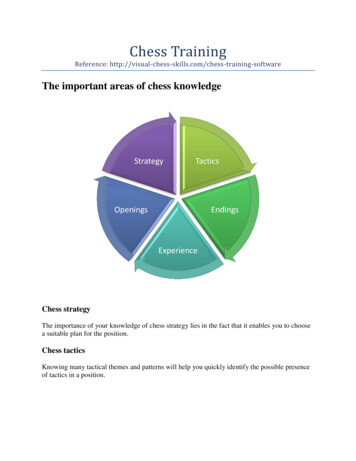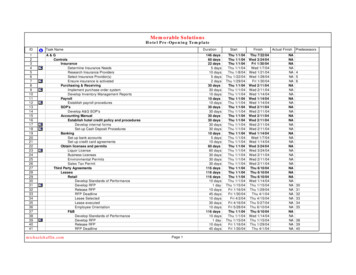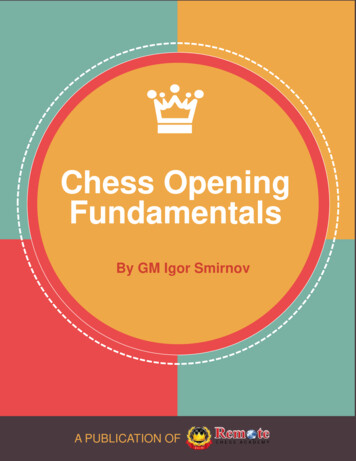
Transcription
Chess OpeningFundamentalsBy GM Igor SmirnovA PUBLICATION OF
ABOUT THE AUTHORGrandmaster Igor SmirnovIgor Smirnov is a chess Grandmaster, coach, and holder of aMaster’s degree in psychology.He’s the founder of the “Remote Chess Academy” companythat has helped thousands of students worldwide to improvetheir results.GM Smirnov has developed lots of chess video lessons, articles,webinars and training courses, including the famous courses“The Grandmaster’s Secrets”, “The Grandmaster’s Positional2Understanding”, and “Calculate Till Mate”.
ABOUT THE BOOKChess Opening FundamentalsWhen you come to play a chess game, it's important tostart it properly. Otherwise you risk falling into an'opening disaster' and lose your game quickly.There are plenty of tutorials that show you tons ofdifferent opening variations. It seems helpful. But howcan you remember all that information? In reality, it canrather confuse you than help you.This E-book contains simple yet very practical tips tomake your opening play powerful and error-free.3
TABLE OF CONTENTS1What is a chess opening?. 52Basic chess opening rules. 113How to play an openings? .184Opening Disaster-1 .245Professional opening preparation .266Two chess opening mistakes you shouldnever make .327Opening disaster 2.40Bonus Video lessons.424
1CHAPTER ONEWhat is a chess opening?5
What is a chess opening?General principles one should follow in the opening stageAn opening is the group of initial moves of a chess game, normally the first10-12 moves. First and foremost, the aim is to control the center and todevelop pieces. What do those first 10-12 moves consist of?Two or three pawn moves in the center.Four to six moves with minor pieces (knight, bishop).King safety (castling).A queen move that ensures connectivity of the rooks.Let us discuss these opening principles more deeply.General opening rules in chess1. The Center-Control the center or attack the center. If you have control there, yourpieces can attack on both sides of the board.2. Develop your pieces-Now the next question is: what is development?A knightDevelopment is “The act or process of growing or causing something togrow or become larger”. The knight placed on g1 controls only threesquares, i.e. h3, f3 and e2.Chapter-1: What is chess opening?6
However, when the knight is developed to f3, it controls eight squares.This is development.Chapter-1: What is chess opening?7
A bishopLikewise, the power of the bishop is also enhanced when it moves from itsinitial square. This is the same with the queen.A rookThe power of the rook is the same whether it is on a1 or e4. It controls only14 squares. The rook on a1 controls a1-a8 and a1-h1, while the rook on e4controls e4-h4, e4-e8, e4-e1 and e4-a4.Thus, a rook on a1 controls two directions but the rook on e4 controls fourdirections. That is why the power of the rook increases in direction and whywe move the rooks in the later stages of the game.Chapter-1: What is chess opening?8
Development best practiceDevelop your pieces without hindering the development of your otherpieces.Example: as White, placing your f1-bishop on d3. This move hinders thedevelopment of the bishop on c1. Instead, make moves which hinder thedevelopment of your opponent’s pieces.Find a suitable square for your piece once and for all.Do not try to bring your queen out early.Castle as early as possible.Try to prevent your opponent from castling.Chapter-1: What is chess opening?9
After following the above rules, it’s now time for you to improve theposition of your queen with a concrete plan. Move your queen and connectyour rooks, and you will have successfully completed the opening.The above diagram is a fine example of both finishing development andconnecting the rooks.Even GMs suffer from opening disastersfrom time to time. Advanced chessknowledge may sometimes deflect youfrom the most important, fundamentalrules.Chapter-1: What is chess opening?10
2CHAPTER TWOBasic chess opening rules11
Basic chess opening rulesFundamental rules of opening playThis lesson is a must-read for beginner players. If you are an experiencedplayer, however, you may still go through the lesson and check if you’rekeeping ALL these rules in mind and following them ALWAYS.In a chess game, the opening stage is very important because it determineswhat kind of middle-game position can arise from it.Each and every opening has different elements – pawn structure, spacecontrol, piece development, etc. At the same time, there are some basicopening principles which are applicable to every opening and which havebeen followed by every advanced chess player and Grand Master.BASIC OPENING PRINCIPLESMove the centre pawns ( e4,d4,e5,d5 ) so that you will gain the initiativein the centre and will have good space.Control or occupy the centre (the centre of the board holds the key to achess game).Develop minor pieces (knights, bishops).Castle your king: the king needs to be safe, as you are going to startattacking in the middlegame and you should not allow any attack onyour king. You can castle on the Kingside (o-o) or the Queenside (o-o-o)– which one depends on the opening you play.Chapter-2: Basic chess opening rules12
Do not move the same piece or pawn twice unless it creates a hugeattack against your opponent or you are winning material (openingstage only).Do not move your queen unless it builds a huge attack on youropponent or you are winning material; the reason for this is that youropponent can easily attack your queen with his minor pieces and youwill have to waste some moves on retreating your queen (opening stageonly).EXAMPLES:Example – 1Let us examine a game which is a very good example for developing minorpieces and not moving your queen– as I have already mentioned above inthe basic opening principlesChapter-2: Basic chess opening rules13
In the diagram above, which arises after the moves 1. e4 e5 2. Qg4 d6 3.Qh5 Nf6 4. Qf3 Bg4 5. Qa3 d5 6. Qa5 Nc6 7. Qa4, White has onlydeveloped his queen, leaving him far behind Black. Meanwhile, Black hasfollowed the principles of development well, bringing three minor piecesinto play and constantly harassing White’s queen.So while White has moved his queen early in the opening stage andcontinued moving it, Black has developed three minor pieces. Black has abetter position here in the opening and can easily win the game.Example – 2Let us see another example based on occupying or controlling the center.In the diagram above, White has done an excellent job in establishingcontrol of the center. His pawns on e4 and d4 control many key squares,while the knights on f3 and c3 are well placed to jump quickly to the centersquares and can even be retreated wherever needed.Conversely, Black has played the first few moves poorly. His pawns on a5and h5 do not influence or control the center at all, and his knights on a6and h6 are limited in their movements and not well placed.Chapter-2: Basic chess opening rules14
Example – 3Let us now see an example of castling the king, as I have mentioned abovein the basic opening principles.In the diagram above, both players have castled within the first five movesof the game. Both kings are quite safe, and neither player needs to fear aquick checkmate here.It is also worth noting that the positions around the kings — specifically, thethree pawns in front of the castled kings — have not been disturbed.Moving these pawns (g4-h4) in the opening will generally make the kingvery vulnerable, as it opens lines of attack for the other player’s pieces.So, as soon as you castle, the safer you are.Chapter-2: Basic chess opening rules15
Example – 4Now we assess a game which contains some basic opening principles. Herethe game goes: 1.e4 e5 2.Nf3 Nc6 3.Bc4 Bc5 – both players have moved their center pawnsand developed minor pieces now.4.c3 Nf6 5.d4 – now White is controlling the center with his central pawnson the d4 and e4 squares.Chapter-2: Basic chess opening rules16
exd4 6.cxd4 Bb6 7.d5 – Black has now lost his center, and White has goodcentral pawns and can develop the other two minor pieces (knight andbishop on b1 and c1) in the next few moves, as well as castle his king.Black’s knight on c6 has to run and this will lose a move, as has alreadyhappened with the bishop going back to b6.Black still has to develop hisbishop on c8 and must castle, although he has lost the center.Basic opening principles are veryimportant and if we apply them in ourgame, we will definitely get a betterposition and can easily play on without anydisturbance.Chapter-2: Basic chess opening rules17
3CHAPTER THREEHow to play an opening?18
HOW TO PLAY AN OPENING?Opening is most important phase of a chess game.Let me start the lesson with a question. Do you know what determines yourWIN/LOSS in a chess game?Which stage of the game determines your win or lose?It’s quite obvious that the opening phase is MORE important, because if youdon’t play it well, you will lose before you can demonstrate yourmiddlegame/endgame skills.Then, here’s the next question you need to think about – how do you playan opening properly?In order to play the opening properly, a lot of people believe that oneshould just study a lot of opening variations and typical ideas/tricks.Although this is partly correct, there’s actually a huge hole here. Let me giveyou an example.Chapter-3: How to play an opening?19
White’s turnAbove, we see the starting position of the Scheveningen variation of theSicilian Defence. What move can White play here?Almost anything! For instance: Be2, Bc4, g3, Be3, f4, g4, Bg5, f3, Qf3 and thelist goes on. Do you really need to study all these lines? Of course NOT!The opening stage lasts for 15-20 moves and on every move bothopponents can play around 10 different logical moves. Ultimately, thisgenerates many thousands (perhaps millions) of variations. Obviously,there’s no way for us to analyse and remember them all.Therefore, we should learn the most logical moves only. For example, in theScheveningen variation, Black certainly should know some theory in themain lines, like 6.Be2, 6.g4, 6.Be3, 6.Bc4.Chapter-3: How to play an opening?20
But what about other possible options for White? Should Black learn the linesarising from 6.Bb5, 6.Nb3, 6.Qf3, 6.h3, etc.?NO! You can’t learn it all anyway. If you dig too deep in your opening study, youwill not have time for mastering other vitally important skills: calculation, tactics,positional play, etc.Chapter-3: How to play an opening?21
Therefore, there can be two situations in an opening:(1) You play a theoretical variation based on your home preparation.(2) Your game turns into a side line or your opponent surprises you with anunexpected move. An unknown position appears and you need to find correctmoves by yourself.These two situations will happen equally often. Again, let’s be realistic. You can’tlearn all possible opening variations – it’s an unworkable aspiration. You need to choose the right openingvariations (your opening repertoire) andlearn the NECESSARY lines within them. You need to know the generalrules/principles of opening play and how youcan find correct moves in unknown openingpositions.Chapter-3: How to play an opening?22
BECOME AN OPENING HEROAre you merely starting out? (or) Haveyou a desire to advance your openingskills?We have the course for youHere, Some of our Openingsuccess stories“The Grandmaster’s OpeningLaboratory” gives you adviceon building solid openingrepertoire.Werner Poets (Belgium)I am amazed how muchmethodologically competently(step by step) this course ismade.Grygoriev Alexey (UKR)CHECK OUR SUPER OPENING COURSES NOW
4CHAPTER FOUROpening Disaster-124
Opening Disaster-1PuzzleUsually a catastrophe in the opening happens when a king stays in thecentre and the position opens quickly with a timed sacrifice. Here we haveone uncharacteristic example. In the Nimzo-Indian Defence Black earlycastled and had quite satisfactory position.In the closed type of the position one could expect a lengthy maneuveringbattle. But Black wanted more and unreasonably sharpened the battle inearly stage of the game. An overoptimistic approach and a lack of alertnessbrought him troubles quickly.Chapter-4: Opening Disaster-125
5CHAPTER FIVEProfessional openingpreparation26
Professional opening preparationPrepare like mastersOpening preparation exerts a strong influence on the final result, when youplay against a strong opponentThat’s why top players use 90-95% of their training time on openingpreparation. Though I don’t recommend you to do the same, it is still a veryimportant topic. In modern chess it is definitely one of the main factors ofyour practical success.I will be glad to give you some recommendations about it in the lesson“Professional Opening Preparation”:Today, it is extremely important to be well prepared for a tournament game.Computers make opening preparation an extremely powerful weapon.That’s why professional players usually spend from 2 to 6 hours on their pregame preparation. If you will not be able to neutralize your opponent'spreparation, you will probably be in huge trouble.Chapter-5: Professional opening preparation27
This aspect has become so important that it is really a huge separate topic,which should be mastered by every modern chess player.In this chess lesson, I will give you some practical advice about it. Let’sbegin.First Advice : Don’t play dubious openingsIn the near past, it was normal to play openings, which are not totallycorrect. People played King’s gambit (1.e4-e5
ABOUT THE BOOK 3 Chess Opening Fundamentals When you come to play a chess game, it's important to start it properly. Otherwise you risk falling into an 'opening disaster' and lose your game quickly. There are plenty of tutorials that show you tons of different opening variations. It seems helpful. But how can you remember all that information? In reality, it can rather confuse you than help .
